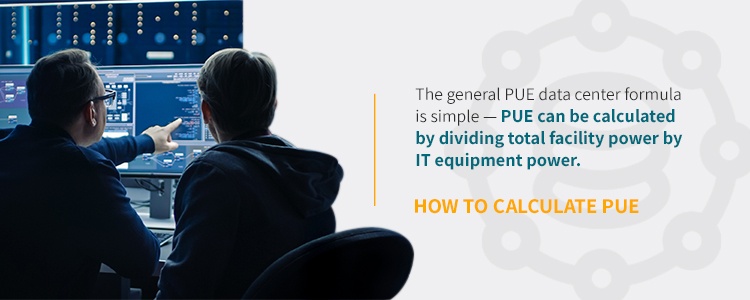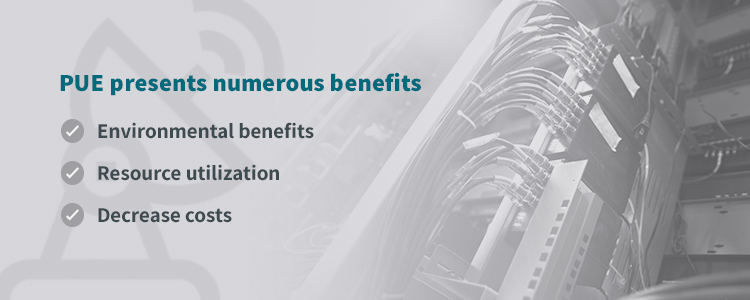
Data Center PUE
Modern technology runs on electricity, and the computers and data centers at the core of daily life require a lot of it. One report from the 2013 Annual Energy Outlook estimated that computers and related equipment accounted for 3% of the United States’ energy consumption. In the search to maximize energy efficiency, many companies are looking into ways to minimize this energy consumption by computers and related equipment. One way many companies are doing this is by benchmarking their data center’s energy efficiency, which is critical to decreasing power use and related costs.
Benchmarking helps companies understand their current efficiency and gives them a metric to judge efficacy as they implement new efficiency best practices. One benchmarking standard commonly used for data centers is PUE. So what is PUE, and how can it be used to improve your data center’s efficiency?
What Does PUE Mean?
PUE stands for Power Usage Effectiveness. Green Grid proposed and developed the idea. Green Grid is a nonprofit IT industry group of experts from different disciplines who collaborate on ways to improve energy efficiency in the industry. Since its introduction, PUE has become the primary metric professionals use to measure energy efficiency in data centers.
IT professionals use PUE as a benchmarking system to determine the energy efficiency of their data centers and monitor efficiency changes over time. Essentially, PUE compares the total energy entering a data center to the energy used by that data center’s IT equipment. The resulting number quantifies how effective the data center is at using the input power. Experts can use this number to understand how the data center compares with similar data centers in similar locations and conditions and determine whether the company needs to improve efficiency through technological or architectural changes.

How to Calculate PUE
The calculations to determine PUE data center numbers are relatively straightforward, but require careful measurement and regular implementation. The general PUE data center formula is simple — PUE can be calculated by dividing total facility power by IT equipment power. These values are defined and explained below:
- Total facility power: Calculating PUE effectively requires knowing how to measure total facility power. Know what components are at play in your data center and how to monitor their performance using the appropriate meters and sensors. You’ll also want to consider building management software that continually monitors power consumption for the facility.
- Find the total IT load: Use direct power supplies for your IT equipment to find the IT load for your data center. This can usually be calculated by using meters to measure activity from the uninterruptible power supply (UPS) and the power distribution unit (PDU).
A value of around 2.0 is average, while a higher value is considered inefficient and a lower value is considered efficient.
How to Use PUE
While the PUE value is important, it is most valuable when tracked carefully and repeatedly over time. Green Grid gives the following guidance for calculating and using PUE and how to improve data center PUE using this information:
- Take measurements: The first step should be to take a thorough reading of your facility’s total power usage and total IT load. Use these measurements to get an overall PUE measurement. This measurement will help determine a course of action.
- Set your objectives: PUE means nothing if it doesn’t inform goals. Create an efficiency improvement plan based on your measurements. This plan may be as simple or as complex as you’d like but should use PUE to set quantifiable and achievable goals. Be sure to set up sensors in appropriate locations to monitor the right areas for specific goals, such as cooler power usage.
- Develop a testing schedule: Regularly test and calculate PUE in your data center. This can easily be programmed as a continuous measurement automated through your software system. Doing this allows your decisionmakers to collect and review PUE data regularly and view both overall PUE for the data center as well as detailed hour-by-hour fluctuations that may help determine how to handle peak loads.
- Take action: Use the data collected to your advantage. Use modeling tools to analyze and adjust airflow, eliminate idle servers, adjust cooling infrastructure settings and update outdated tech. Use tests to determine if the changes have made significant improvements and repeat the cycle as many times as needed.
Following these steps can help leverage PUE to your company’s advantage, and there are many advantages PUE can offer.

The Benefits of PUE
As discussed previously, data centers consume massive amounts of energy. One study found that U.S. data centers consumed approximately 70 billion kilowatt-hours in 2014, which is about 1.8% of national electricity consumption. This power usage represents both an environmental and a cost concern to many businesses. With the introduction of PUE, however, businesses now have a way to quantify efficiency. This presents numerous benefits, including the following:
- Environmental benefits: Energy consumption represents a massive carbon footprint within the IT industry. Previously, companies did not have a way to quantify efficiency, which made it easier to lose track of this value. PUE creates a simple system to quantify efficiency, which makes it easier for businesses to visualize, prioritize and implement efficiency initiatives. This has effectively increased the creation of eco-friendly computing centers.
- Resource utilization: Implementing a PUE monitoring plan is a great way to visualize and monitor all areas of a data center. The resulting data can be used to identify wasted or under-utilized resources, allowing decisionmakers to reallocate those resources effectively.
- Decrease costs: The ultimate bottom line for any business is cost, and using PUE is a great way to help save money. Maximizing efficiencies can save money on electricity bills and ensure that resources are used effectively.
By automating PUE calculation and analysis, your business can maximize these benefits by eliminating manual intervention. As advanced systems become more readily available, we may see these calculations even used to manage energy sources and optimize efficiencies automatically.
Learn More From DataSpan
If you want to learn more about calculating or leveraging PUE for your data center, DataSpan can help. For 50 years, DataSpan continues to be a national technology solutions provider. From IT physical infrastructure to data center IT services, we help our customers accomplish more with fewer resources.
Contact DataSpan today to learn more about our services and how they can help your business improve efficiencies.







